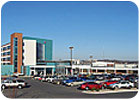
This hospital had three different fire protection systems from three manufacturers, which created confusion whenever there was a fire event or emergency situation. An intelligent analog/addressable fire alarm control panel proved to be a perfect solution when the facility was due for an upgrade.
For Freeman Health System, expansion was just what the doctor ordered. After all, this 392-bed, not-for-profit, three-hospital system provides comprehensive health care and behavioral health services to an area that includes more than 450,000 residents from Missouri, Arkansas, Oklahoma, and Kansas. With 398,219 outpatient visits, 21,717 admissions, and 110,298 emergency department/trauma/urgent care visits, Freeman needed to substantially enlarge its physical facilities to accommodate these impressive and ever increasing numbers.
To that end, plans were developed for a major expansion of Freeman West, the largest of the three Freeman campuses located in Joplin, MO. The result was the creation of a six-story tower attached to Freeman’s two-story flagship hospital. The tower houses an impressive range of resources, including the hospital’s emergency room, IT department, conference rooms, and post-surgery recovery rooms. Two patient floors (with two more in the works) have effectively doubled Freeman’s bed capacity. The hospital has also installed a cutting-edge shock/trauma bay and is, in fact, one of only two facilities in the world offering it.
Three-headed Monster
Of course, along with the new building expansion came the need to extend Freeman’s fire protection system. The prognosis in this area was not as favorable. The main hospital already had three fire protection systems from three manufacturers; the third had been installed to accommodate a previous, smaller expansion project. The problem was that none of the systems were capable of handling the additional points needed for the proposed tower.The inability to accommodate the expansion was only a part of the problem. The use of three different fire protection systems created confusion whenever there was a fire event or emergency situation, requiring personnel to check several different panels in multiple locations to determine the cause.
When a fire-protection plan for the new building had to be developed, Freeman turned to Neil Spencer, life safety systems manager for Joplin Fire Protection. Spencer recognized immediately that none of the existing systems would fit the bill.
“Although the last system we installed performed fine, we knew it was not capable of taking Freeman into its next phase of growth,” said Spencer, who oversees sales, service, and installation of all fire alarm and life safety systems for Joplin. “And we didn’t want to add yet another system that wouldn’t be capable of expanding in the future.”
Working with Daniel Caylor, Freeman’s director of facilities management, Spencer recommended the Farenhyt IFP-1000 from the Silent Knight, part of the Honeywell Life Safety Group.
The Farenhyt IFP-1000 is an intelligent analog/addressable fire alarm control panel that offers built-in capacity for 198 addressable devices with expansion to 1,584 addressable devices using the IDP protocol. Features like individual point identification, drift compensation, and maintenance alert help the system reduce the number of false alarms and service calls. The IFP-1000 also supports a full range of detectors, modules, and power supplies. The flexibility of the IFP-1000 is also evidenced by the fact that central station reporting can be performed either by point or by zone.
Along with the IFP-1000, Joplin upgraded all of the hospital’s ancillary devices to addressable modules and ensured that each performed up to all state and local codes. Such upgrades included new smoke detectors, heat detectors, and chime strobes in place of horn strobes.
AHU Shutdown and More
The system is programmed to perform a number of functions in case of a fire emergency, including shutting down AHUs, closing smoke and fire dampers, electronically locking fire doors, and recalling all elevators. The hospital’s sprinkler system is also connected to the IFP-1000.Because the system automatically tests the connected addressable devices, Freeman personnel no longer have to canvass the facility with a smoke detector sensitivity tester every two years to test them; this capability is built directly into the panel.
“Before, with the three separate systems, the hospital personnel were jumping back and forth trying to find out where a problem had originated,” Spencer said. “Now they can go to their remote annunciators anywhere in the hospital and find out what’s going on almost instantly.” Since Freeman personnel respond to their own fires, this is critical. Evacuating people is often not an option. So the more quickly they can respond, the better.
In the end, Joplin was able to take an inefficient, multi-system approach to fire protection and mold it into an easy-to-use, single-location system for the new millennium. Now that’s a prescription for a very safe and healthy hospital.ES
